In the early 1910s, French actress Renée Sylvaire was one of the regular actresses of the company Éclair. She played in over 60 silent films between 1909 and 1923.
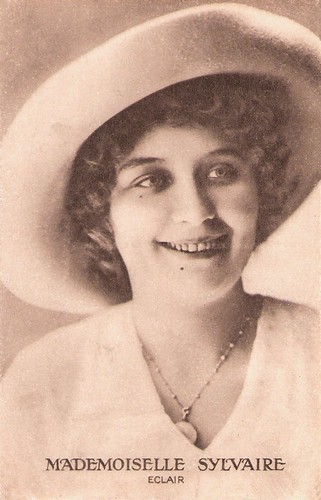
French postcard. Photo: Eclair.
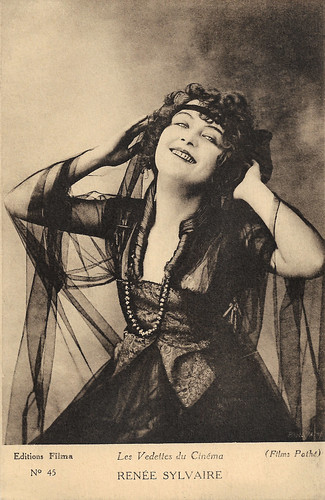
French postcard in Les Vedettes du Cinéma Series by Editions Filma, no. 45. Photo: Films Pathé.
When Renée Sylvaire was born is unknown. She began her career in the theatre and made her film debut when onereelers still ruled in film. Her first known film role was in Rédemption/John Farley's Redemption (Victorin-Hippolyte Jasset, 1909), where she played opposite Charles Krauss, one of the regulars of the Éclair company.
The plot of this film is not far afield from the scandal of American star Evelyn Nesbit's real life, in which her husband murdered famed architect Stanford White in retaliation for his presumed affair with Nesbit.
After this debut it took some time before Sylvaire could continue at Éclair, as in 1910 the company focused on classic plays with mainly acclaimed stage actors.
Instead she played at Pathé in such short films as Une petite femme bien douce/A Sweet Little French Lady (Georges Denola, 1910) with Mistinguett, and Philémon et Baucis (Georges Denola, 1911) with Romuald Joubé.
In 1911, she returned to Éclair to play in such shorts as La fleur des neiges/The Snow Flower (1911), and Le grand-pere/The Grandfather (1911), and her first feature film La dame de chez Maxim's/Girl from Maxim's (1912), an adaptation of the Georges Feydeau comedy. All these films were made under the solid direction of Emile Chautard. The script for La dame de chez Maxim's was written by Maurice Tourneur, who would later direct her in several films.

Mistinguett French postcard, no. 176. Collection: Didier Hanson.
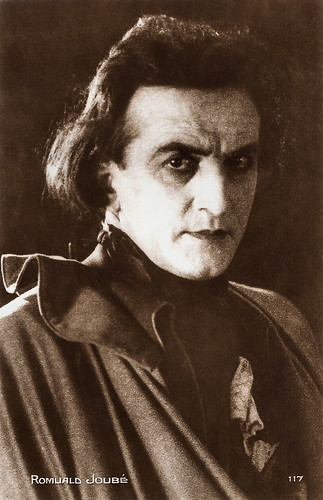
Romuald Joubé. French postcard by Editions Cinémagazine, no. 117.
1913 was an enormously productive year for Renée Sylvaire. She played in the onereeler La malédiction/The Curse (Emile Chautard, 1913), and the two-reelers Le chemin du coeur/The Way of the Heart (1913) with Charles Krauss, L’assaut de la terre/The Assault of the Earth, Le trésor des Baux/Baux's Treasure, Sacrifice, two episodes of the serial Destin tragique/Tragic Destiny, La maison du glacier/The House of the Ice-cream Maker (all directed by Victorin-Hippolyte Jasset in 1913), La bergère d’Ivry (Maurice Tourneur, known to be his earliest surviving film, 1913) about the plight of an orphan girl, and the horrifying Le système du docteur Gourdon et du professeur Plume/The Lunatics (Maurice Tourneur, 1913), adapted from a one-act Grand Guignol play based on Edgar Allen Poe’s short story The System of Dr. Tarr and professor Fether.
Sylvaire played the female lead in the threereelers Mathilde (Emile Chautard, 1913) after the novel by Eugène Sue, La gueuse (unknown director, 1913), and Le chiffonier de Paris/The Ragman of Paris (Emile Chautard, 1913). She also had major roles in the threereelers La justicière/The Female Leader (Gérard Bourgeois, Victorin-Hippolyte Jasset, 1913) opposite Josette Andriot, and Le coeur d’une gosse/The heart of a Street Urchin, (Emile Chautard, 1913).
Sylvaire also played in the four-reelers Jack (André Liabel, 1913), an adaptation of Alphonse Daudet’s novel featuring Villeneuve, and La fiancée maudite/The Accursed Fiancé (Emile Chautard, 1913) with Josette Andriot. Finally Sylvaire also played in two films of which the length is unknown, Val d'enfer/Hell Valley (Victorin-Hippolyte Jasset, 1913) and in another Feydeau adaptation La duchesse des Folies-Bergères/The Duchess of the Folies-Bergères (Emil Chautard, 1913, ).
Next to the above mentioned titles from the Éclair filmography published in 1992, IMDb lists five other short 1913 films with Sylvaire. These are Trompe-la-Mort/Mistaken Death (Charles Krauss, 1913) based on a novel by Honoré de Balzac, Soeurette (Maurice Tourneur, 1913) with Pauline Polaire, Les ruses de l'amour/The Tricks of Love (Maurice Tourneur, 1913), L’auberge sanglante/The Inn of Blood (Emile Chautard, 1913), and La nièce d’Amérique/The American Niece (Gérard Bourgeois, 1913). Harry Waldman’s study of Maurice Tourneur also mentions Le dernier pardon (Maurice Tourneur, 1913). A total of 23 (short) films - all done in 1913!
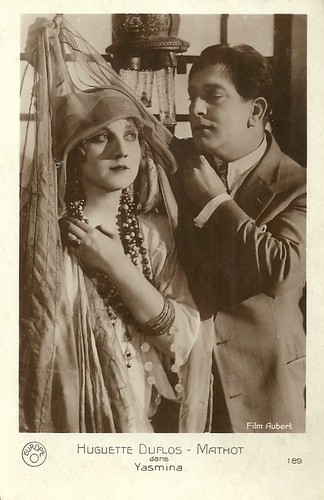
Huguette Duflos. French postcard by Europe, no. 189. Photo: Film Aubert. Publicity still of Huguette Duflos and Léon Mathot in Yasmina (André Hugon, 1927).
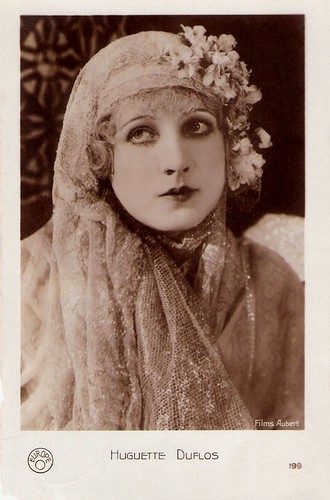
French postcard by Europe, no. 199. Photo: Films Aubert.
In 1914, Renée Sylvaire continued her fruitful and busy career at Éclair. She alternated major or minor film roles with leading roles. She was the female star of the two-reeler comedy Mademoiselle Josette, ma femme/Miss Josette, My Wife (André Liabel, 1914) and of the threereeler drama Le corso rouge/The Red Procession (Charles Krauss, Maurice Tourneur, 1914). She could also be seen a.o. in the fourreeler (feature-length) comedy set in a circus milieu Le friquet (Maurice Tourneur, 1914), starring Pauline Polaire; the threereeler Le puits mitoyen/The Secret of the Well (Maurice Tourneur, 1914) with Henry Roussel; and the tworeeler comedy L’idée de Françoise/Francis' Idea (Emil Chautard, 1914).
Figures de cire/Wax Figures (Maurice Tourneur, 1914) was another Grand Guignol-story based on Le système du docteur Gourdon et du professeur Plume. It was the forerunner of Paul Leni’s classic Waxworks/Wachsfigurenkabinett (1924). In May 1914, Maurice Tourneur left for the US to work at the Éclair studio’s in Fort Lee, thus robbing Sylvaire of an innovative director. When the First World War broke out and production at Éclair was reduced to mostly short comedies and non-fiction, Sylvaire also played less roles.
In 1915 she only played in the third sequel of the Protéa adventure serial: La course à la mort/The Death Race (Joseph Faivre, supervised by Gérard Bourgeois, 1915) with Josette Andriot and the future director Jacques Feyder. In 1916 followed only the threereeler Un coup de feu dans la nuit/A Shot in the Night (Gérard Bourgeois, 1916). Then she appeared in Le mort invisible/The Invisible Death (Adolphe Candé, 1917), the fourth part of the Protéa series: Les mystères du Chateau Malmort/The Mysteries of the Castle of Malmort (Gérard Bourgeois, 1917), and L’âpre lutte/The Fierce Struggle (Jacques de Féraudy, Robert Boudrioz, 1917).
Sylvaire had been an actress at the Theatre du Renaissance, but was now engaged at the Theatre du Grand Guignol. In 1918 Sylvaire still played in one more film by Éclair La distance/The Distance (Robert Boudrio, 1918). Then she left Éclair as the company was falling apart. When the fifth Protéa sequel came out in early 1919, the last film released by Éclair, Josette Andriot had another co-star. In 1918 Sylvaire played for Pathé in La route du devoir/The Journey of Duty (Georges Monca, 1918) with Charles Prince, and Le boudoir japonais/The Japanese Boudoir (Georges Monca, 1918) and had a lead in Le fils naturel/The Natural Son (Jacques de Baroncelli, 1918), after Alexandre Dumas fils.
The following year she played in L’impasse Messidor/The Messidor Cul-de-sac (Camille de Morlhon, 1919), Le sang des immortelles/The Blood of the Immortals (André Liabel, 1919), and La gloire douloureuse/The Painful Glory (Maurice Landais, 1919). The next years Sylvaire played the lead in Les femmes des autres/Other Men's Wifes (Pierre Marodon, 1920), Des fleurs sur la mer/Flowers on the Sea (André Liabel, 1922) and Etre ou ne pas être/To Be or Not To Be (René Leprince, 1922) with Léon Mathot.
In 1923 she still had substantial roles in Le château des fantômes/The Haunted Castle (Pierre Marodon, 1923), and L'ile sans amour/The Island Without Love (Jean Legrand, 1923). Her last known role was a small part in the spectacular production Koenigsmark/The Secret Spring (Léonce Perret, 1923). This film featured a whole new generation of film stars: Huguette Duflos, Jaque Catelain, Iván Petrovich, etc.
Renée Sylvaire was married to the actor and director André Liabel, with whom she worked several times during her career. Sylvaire’s last film credit was as an assistant director for La closerie des Genêts/The Croft of the Genêts (1924), a film directed by her husband.
The film career of Renée Sylvaire halted here and there is no information about her later life. About her stage career is not much known either. Happily several films with Renée Sylvaire have shown up over the last decades. In the Desmet Collection of the Eye Film Institute were found a.o. Le coeur et les yeux, Amours et science, and La bergère d’Ivry. A few years ago also Maurice Tourneur’s Le friquet showed up and has been restored since.
Whoever has more information about Renée Sylvaire, please mail us.
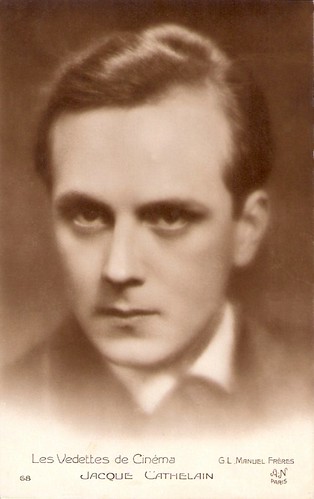
Jaque Catelain. French postcard by A.N., Paris. in the Les vedettes de Cinema series, no. 68. Photo: G.L. Manuel Frères.
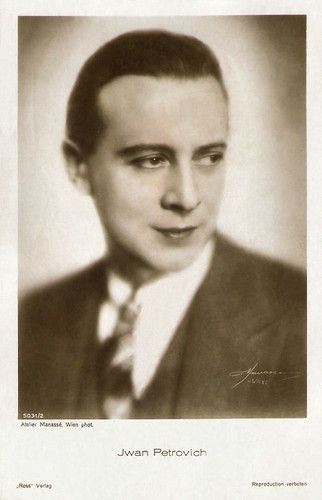
Iván Petrovich. German postcard by Ross Verlag, no. 5031/2, 1930-1931. Photo: Atelier Manassé, Wien.
Sources: Filmography Éclair (Griffithiana 44/45, 1992); Marlène Pilaete (L'encinémathèque - French), Harry Waldman (Maurice Tourneur. The life and films), and IMDb.

French postcard. Photo: Eclair.

French postcard in Les Vedettes du Cinéma Series by Editions Filma, no. 45. Photo: Films Pathé.
American Scandal
When Renée Sylvaire was born is unknown. She began her career in the theatre and made her film debut when onereelers still ruled in film. Her first known film role was in Rédemption/John Farley's Redemption (Victorin-Hippolyte Jasset, 1909), where she played opposite Charles Krauss, one of the regulars of the Éclair company.
The plot of this film is not far afield from the scandal of American star Evelyn Nesbit's real life, in which her husband murdered famed architect Stanford White in retaliation for his presumed affair with Nesbit.
After this debut it took some time before Sylvaire could continue at Éclair, as in 1910 the company focused on classic plays with mainly acclaimed stage actors.
Instead she played at Pathé in such short films as Une petite femme bien douce/A Sweet Little French Lady (Georges Denola, 1910) with Mistinguett, and Philémon et Baucis (Georges Denola, 1911) with Romuald Joubé.
In 1911, she returned to Éclair to play in such shorts as La fleur des neiges/The Snow Flower (1911), and Le grand-pere/The Grandfather (1911), and her first feature film La dame de chez Maxim's/Girl from Maxim's (1912), an adaptation of the Georges Feydeau comedy. All these films were made under the solid direction of Emile Chautard. The script for La dame de chez Maxim's was written by Maurice Tourneur, who would later direct her in several films.

Mistinguett French postcard, no. 176. Collection: Didier Hanson.

Romuald Joubé. French postcard by Editions Cinémagazine, no. 117.
The enormously productive year 1913
1913 was an enormously productive year for Renée Sylvaire. She played in the onereeler La malédiction/The Curse (Emile Chautard, 1913), and the two-reelers Le chemin du coeur/The Way of the Heart (1913) with Charles Krauss, L’assaut de la terre/The Assault of the Earth, Le trésor des Baux/Baux's Treasure, Sacrifice, two episodes of the serial Destin tragique/Tragic Destiny, La maison du glacier/The House of the Ice-cream Maker (all directed by Victorin-Hippolyte Jasset in 1913), La bergère d’Ivry (Maurice Tourneur, known to be his earliest surviving film, 1913) about the plight of an orphan girl, and the horrifying Le système du docteur Gourdon et du professeur Plume/The Lunatics (Maurice Tourneur, 1913), adapted from a one-act Grand Guignol play based on Edgar Allen Poe’s short story The System of Dr. Tarr and professor Fether.
Sylvaire played the female lead in the threereelers Mathilde (Emile Chautard, 1913) after the novel by Eugène Sue, La gueuse (unknown director, 1913), and Le chiffonier de Paris/The Ragman of Paris (Emile Chautard, 1913). She also had major roles in the threereelers La justicière/The Female Leader (Gérard Bourgeois, Victorin-Hippolyte Jasset, 1913) opposite Josette Andriot, and Le coeur d’une gosse/The heart of a Street Urchin, (Emile Chautard, 1913).
Sylvaire also played in the four-reelers Jack (André Liabel, 1913), an adaptation of Alphonse Daudet’s novel featuring Villeneuve, and La fiancée maudite/The Accursed Fiancé (Emile Chautard, 1913) with Josette Andriot. Finally Sylvaire also played in two films of which the length is unknown, Val d'enfer/Hell Valley (Victorin-Hippolyte Jasset, 1913) and in another Feydeau adaptation La duchesse des Folies-Bergères/The Duchess of the Folies-Bergères (Emil Chautard, 1913, ).
Next to the above mentioned titles from the Éclair filmography published in 1992, IMDb lists five other short 1913 films with Sylvaire. These are Trompe-la-Mort/Mistaken Death (Charles Krauss, 1913) based on a novel by Honoré de Balzac, Soeurette (Maurice Tourneur, 1913) with Pauline Polaire, Les ruses de l'amour/The Tricks of Love (Maurice Tourneur, 1913), L’auberge sanglante/The Inn of Blood (Emile Chautard, 1913), and La nièce d’Amérique/The American Niece (Gérard Bourgeois, 1913). Harry Waldman’s study of Maurice Tourneur also mentions Le dernier pardon (Maurice Tourneur, 1913). A total of 23 (short) films - all done in 1913!

Huguette Duflos. French postcard by Europe, no. 189. Photo: Film Aubert. Publicity still of Huguette Duflos and Léon Mathot in Yasmina (André Hugon, 1927).

French postcard by Europe, no. 199. Photo: Films Aubert.
Grand Guignol
In 1914, Renée Sylvaire continued her fruitful and busy career at Éclair. She alternated major or minor film roles with leading roles. She was the female star of the two-reeler comedy Mademoiselle Josette, ma femme/Miss Josette, My Wife (André Liabel, 1914) and of the threereeler drama Le corso rouge/The Red Procession (Charles Krauss, Maurice Tourneur, 1914). She could also be seen a.o. in the fourreeler (feature-length) comedy set in a circus milieu Le friquet (Maurice Tourneur, 1914), starring Pauline Polaire; the threereeler Le puits mitoyen/The Secret of the Well (Maurice Tourneur, 1914) with Henry Roussel; and the tworeeler comedy L’idée de Françoise/Francis' Idea (Emil Chautard, 1914).
Figures de cire/Wax Figures (Maurice Tourneur, 1914) was another Grand Guignol-story based on Le système du docteur Gourdon et du professeur Plume. It was the forerunner of Paul Leni’s classic Waxworks/Wachsfigurenkabinett (1924). In May 1914, Maurice Tourneur left for the US to work at the Éclair studio’s in Fort Lee, thus robbing Sylvaire of an innovative director. When the First World War broke out and production at Éclair was reduced to mostly short comedies and non-fiction, Sylvaire also played less roles.
In 1915 she only played in the third sequel of the Protéa adventure serial: La course à la mort/The Death Race (Joseph Faivre, supervised by Gérard Bourgeois, 1915) with Josette Andriot and the future director Jacques Feyder. In 1916 followed only the threereeler Un coup de feu dans la nuit/A Shot in the Night (Gérard Bourgeois, 1916). Then she appeared in Le mort invisible/The Invisible Death (Adolphe Candé, 1917), the fourth part of the Protéa series: Les mystères du Chateau Malmort/The Mysteries of the Castle of Malmort (Gérard Bourgeois, 1917), and L’âpre lutte/The Fierce Struggle (Jacques de Féraudy, Robert Boudrioz, 1917).
Sylvaire had been an actress at the Theatre du Renaissance, but was now engaged at the Theatre du Grand Guignol. In 1918 Sylvaire still played in one more film by Éclair La distance/The Distance (Robert Boudrio, 1918). Then she left Éclair as the company was falling apart. When the fifth Protéa sequel came out in early 1919, the last film released by Éclair, Josette Andriot had another co-star. In 1918 Sylvaire played for Pathé in La route du devoir/The Journey of Duty (Georges Monca, 1918) with Charles Prince, and Le boudoir japonais/The Japanese Boudoir (Georges Monca, 1918) and had a lead in Le fils naturel/The Natural Son (Jacques de Baroncelli, 1918), after Alexandre Dumas fils.
The following year she played in L’impasse Messidor/The Messidor Cul-de-sac (Camille de Morlhon, 1919), Le sang des immortelles/The Blood of the Immortals (André Liabel, 1919), and La gloire douloureuse/The Painful Glory (Maurice Landais, 1919). The next years Sylvaire played the lead in Les femmes des autres/Other Men's Wifes (Pierre Marodon, 1920), Des fleurs sur la mer/Flowers on the Sea (André Liabel, 1922) and Etre ou ne pas être/To Be or Not To Be (René Leprince, 1922) with Léon Mathot.
In 1923 she still had substantial roles in Le château des fantômes/The Haunted Castle (Pierre Marodon, 1923), and L'ile sans amour/The Island Without Love (Jean Legrand, 1923). Her last known role was a small part in the spectacular production Koenigsmark/The Secret Spring (Léonce Perret, 1923). This film featured a whole new generation of film stars: Huguette Duflos, Jaque Catelain, Iván Petrovich, etc.
Renée Sylvaire was married to the actor and director André Liabel, with whom she worked several times during her career. Sylvaire’s last film credit was as an assistant director for La closerie des Genêts/The Croft of the Genêts (1924), a film directed by her husband.
The film career of Renée Sylvaire halted here and there is no information about her later life. About her stage career is not much known either. Happily several films with Renée Sylvaire have shown up over the last decades. In the Desmet Collection of the Eye Film Institute were found a.o. Le coeur et les yeux, Amours et science, and La bergère d’Ivry. A few years ago also Maurice Tourneur’s Le friquet showed up and has been restored since.
Whoever has more information about Renée Sylvaire, please mail us.

Jaque Catelain. French postcard by A.N., Paris. in the Les vedettes de Cinema series, no. 68. Photo: G.L. Manuel Frères.

Iván Petrovich. German postcard by Ross Verlag, no. 5031/2, 1930-1931. Photo: Atelier Manassé, Wien.
Sources: Filmography Éclair (Griffithiana 44/45, 1992); Marlène Pilaete (L'encinémathèque - French), Harry Waldman (Maurice Tourneur. The life and films), and IMDb.
1 comment:
What an amazing woman she was! I would dearly love to read about what happened after her career waned. How wonderful that you are bringing these actors/actresses of old to the forefront. Your posts are so interesting. :D Merry Christmas!
Post a Comment